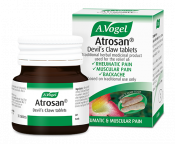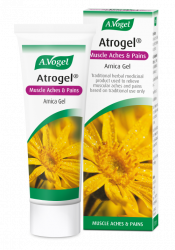Why have I got joint pain?
Joint pain is an issue I get asked a lot about here at A.Vogel, so today I thought I would shed a little more light on the problem.
Some possible reasons for joint pain are:
- Arthritis
- Menopause
- Gout
- Injury
- Aging
- Medication
Let's take a closer look at these issues and what can be done about them.
1. Arthritis
There are three main types of arthritis that can cause a range of symptoms including stiffness, pain and inflammation. These are:
- Osteoarthritis – this occurs due to wear and tear in the cartilage between the joints. Protective cartilage wears away, causing the bones to rub together, which is very painful. Sometimes this friction can cause bony growths called spurs to appear on the joint, which is also very uncomfortable.
- Rheumatoid arthritis – this is an autoimmune condition where the body turns on its own tissues and attacks them, causing pain and inflammation. It can occur in various joints, including the fingers and knees.
- Post-traumatic arthritis – this usually develops if there has been an injury to the area, such as a torn ligament. It typically causes symptoms like swelling, pain and weakness.
Treatments for arthritis
Follow an anti-inflammatory diet – eat oily fish 3 times a week; plus, lots of colourful veg, nuts, seeds and avocados should be dietary priorities.
Avoid inflammatory foods - in general, highly-processed foods, such as ready meals, crisps and fizzy juice, can cause problems.
Try cutting out the 'nightshade' family – try this for a month to see if this makes a difference. Many people report dramatic improvement when they remove these foods, which encompass potato, tomato, aubergine and peppers.
Try gentle exercises - it is important to keep the body moving so try low impact activities like yoga which don't put too much strain on the joints. You could also consider seeing a physiotherapist or Pilates instructor, who can tailor exercises to suit your condition.
Apply warm and cold compresses - alternate between heat and cold compresses, as you may find that one option suits your problem better than the other. There may not be much inflammation present - for example, if it's a long-standing issue and the pain is mainly triggered by calcified deposits - in which case heat may be more beneficial.
My Top Tip:

"This is a great product recommended by my Naturopath for chronic pain relief and it does take the edge off."

2. Menopause
The hormonal changes that occur during the menopause can make pain and weakness in the bones, muscles and joints more likely to occur.
Our Menopause Expert Eileen talks a little more about this on her page 'Causes of menopausal joint pain and how to ease it'.
Symptoms typically affect the elbows, neck, shoulders, hands and fingers and are most likely to develop between the ages of 45 and 55.
Stress, weight gain, dehydration and diet are all factors that can influence menopausal aches and pains.
Treatments for menopausal aches and pains
Ensure you are properly hydrated – aim to drink at least 1.5-2l of plain, still water daily and cut down on caffeinated drinks.
Reduce sugar intake – this may help manage aches and pains. Opt for foods that are naturally sweet if you need a sugar kick, rather than highly processed options.
Stay active - swimming and cycling are good options, as these don't tend to put too much strain on the joints.
Get plenty of magnesium - this will also aid muscles, bones and joints.
Try Menopause Support – this provides support during all stages of the menopause and contains magnesium, which is known to help with tiredness and fatigue, which are also common in menopause.
3. Gout
Gout can cause severe and sudden joint pain, usually in the toes, fingers, wrists, elbows or knees. As well as being painful, the skin may turn red, swollen and warm to touch.
Gout is caused by a build-up of uric acid, which can be associated with weaker circulation and dehydration. It can also be linked to hot weather, or may worsen in hot weather. Other factors that may contribute to the problem include drinking a lot of fizzy juice (especially diet fizzy drinks), plus high alcohol and caffeine intake.
You should see your doctor if you are concerned about gout but, if you have already had a diagnosis, you may find the lifestyle tips below helpful.
Treatments for gout
Cut down your intake of caffeine and fizzy drinks – including diet options and energy drinks. Switch to a herbal tea like Golden Rod, which may be helpful for gout-related symptoms, or nettle tea, which may help to reduce uric acid levels.
Move as much as possible – opt for gentle activities like yoga and cycling.
Get more vitamin C – this may help to counter high levels of uric acid in the body. A natural supplement can help increase your intake further.
Reduce consumption of high purine foods – these include red meat, game and some fish, as well as drinks like alcohol.
Consume foods that may help to lower uric acid levels– this includes fruit and vegetables such as cherries. Cherries also have anti-inflammatory properties and are a rich source of antioxidants.
4. Injury
Are you aware of a practical reason for your pain, such as a fall? Often this can contribute to painful joints, even if the injury didn't feel like such a big issue at the time of impact!
An injury may also cause you to hold your body differently, which can lead to additional problems. You see, it's hard to avoid using weight-bearing joints like our knees so, if the area is painful, we often subconsciously change our posture to avoid putting pressure on the uncomfortable area. This can skew our musculature and can add to the problem; or it may cause issues to crop up elsewhere.
Repetitive Strain Injury (RSI) is another common cause of joint pain. This often occurs in the finger or wrist joints, due to movements like typing. Driving can also cause RSI to the shoulder joints, whilst running can lead to the problem developing in the knees.
Treatments for joint injuries
Rest – joint injuries can take time to heal so, even though it may be difficult, try to keep the affected area rested as much as possible. Hold off from doing any high impact exercises and stick to gentle activities like walking once you're up and moving again.
Apply Atrogel Arnica gel – as long as the skin is not broken, you may find it helpful to apply Atrogel to the affected area. This pleasant-smelling gel can be very soothing and has beneficial anti-inflammatory and pain-relieving properties. It brings quick relief, which is a real benefit too.
See a physiotherapist – injuries to the joints, and the knee joints in particular, are notoriously difficult to treat. I suggest that you ask for a referral to a physiotherapist if the problem persists.
Consult an osteopath – here they use massage, movement and stretching to help sort out musculoskeletal issues. A cranial osteopath will work with soft tissue in very subtle ways.
5. Aging
Everyday activities and even our jobs can take their toll on the health of the joints, meaning aches and pains become more likely as we get older. This wear and tear isn't inevitable, though, and making some changes can bring relief.
Treating joint pain due to aging
Use Atrogel Arnica Gel – this should ease inflammation and stiffness in the joints.
Increase your magnesium intake – low magnesium levels are associated with aches and pains, so try to increase your intake. Good food sources are deep green veg, almonds, hazels, brown rice, dates, figs and dried apricots.
Drink more water – this is an important step in managing joint pain.
Take glucosamine sulphate – take this long-term to strengthen the connective tissue. You should be able to find this in your nearest health food store. The earlier you can start taking this the better!
Keep moving – check out our blog '5 exercise tips for older adults' if you need further advice.
6. Medication
Some medications are associated with joint pain. Statins, in particular, have been linked with muscle and joint pain. These are widely prescribed to treat high cholesterol.
Treating joint pain due to medication
Consult your doctor – it is important that you continue to take prescribed medicines, even if they contribute to new symptoms. However, you should consult your doctor to let them know about your symptoms, just in case your medications need to be revised.
Apply Atrogel Arnica gel – this topical gel can be applied externally to help with muscle and joint pains.
Other causes of joint pain
Although I have explained some of the most common reasons for joint pain, there are other a number of other things that could explain your discomfort, including:
- An allergic reaction to medication
- Arthrofibrosis
- Autoimmune disease
- Bursitis
- Infection
- High vitamin A intake
- Tennis elbow
If you are still unsure about the cause of your joint pain or need further advice, please consult your doctor.








